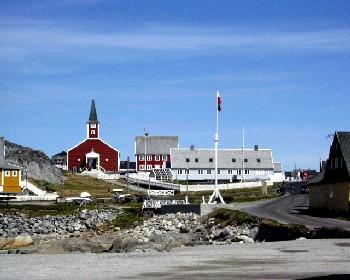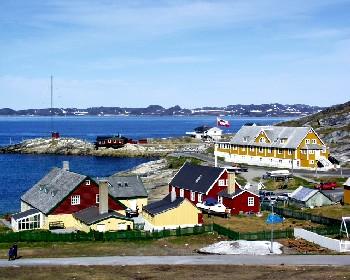
|
|
10 June, 2000
It's all in the pastů
Before we set sail, I thought I would give you a short history lesson on
Greenland. Much of the early history, including both the Inuit and Norse
cultures, is up for debate. There are many theories of the evolution of the
Inuit culture and the development and ultimate demise of the Norse culture.
The Inuit history dates back 5,000 years ago and can be divided into
several time periods with distinct cultural entities. It is believed that
the first migrants were of the Stone Age. The Independence I culture is
thought to have been made up of fewer that 500 individuals that settled in
the northern most regions of Greenland. Over the next 1,000 to 2,000 years,
they developed into or were displaced by subsequent cultures that began to
migrate to the south in sites along the eastern and western coasts of
Greenland. Communal societies and the use of weapons, ornamented hunting
tools and sleds appear to have developed around 2,500 years ago. The
modern-day Inuit are thought to have descended from the Thule culture that
swept out of western Alaska, eastward through Greenland during the 10th and
11th centuries. The Thule culture is credited with the development of the
kayak, or qajag, the harpoon, and the dogsled, all of which are still used
in today's Inuit culture.
The Norse history is based on two writings done after the fact. These
stories give an accounting of several individuals who stumbled onto
Greenland accidentally or were outlaws escaping justice in Iceland, none of
which tried to settle Greenland permanently. During the late 10th century,
Eric the Red left Norway, then Iceland to flee justice. After successfully
settling a farm, Eric went back to Iceland and managed to sell the idea of
his new settlement to others. The Western settlement around the area of
Nuuk, Greenland's present day capital thrived with hundreds of farms and a
population of around 5,000. Settlers farmed sheep and cattle, and took
advantage of local resources such as seal, walrus, caribou, and polar bears.
By the 15th century the all of the colonies had disappeared. Some believe
that climate changes caused the disappearance, while others think that the
Inuit or English pirates eliminated the population of the colonists. The
ultimate cause will likely be debated for years to come.
With interest in finding the North-West passage and the rich resources for
whaling, Norway began to show an interest in Greenland. In 1605, Danish
king Christian IV sent out an expedition to Greenland which claimed it for
Denmark. Permanent settlement did not occur until missionaries started
settlements in the 1720's. Nuuk became settled in 1728 and is now the
capital of Greenland. More recently, both Norway and Denmark laid claim to
Greenland. International courts settled the dispute in the 1930's by
declaring Denmark sovereign over Greenland. In 1953 Green land became a
county of Denmark, giving its inhabitants full Danish citizenship. Over
that past twenty years, Greenland has strived for more independence and has
moved toward a Home Rule government.
This has been a very broad overview of Greenlandic history, of which I
have left out many interesting stories. All of the history deserves a much
more detailed accounting. I encourage you all to get to your local library
and check out books to find out more about the Inuit and Norse cultures that
have shaped the history of Greenland.

Nuuk, Greenland.

A Nuuk sunset.


Contact the TEA in the field at
.
If you cannot connect through your browser, copy the
TEA's e-mail address in the "To:" line of
your favorite e-mail package.
|
